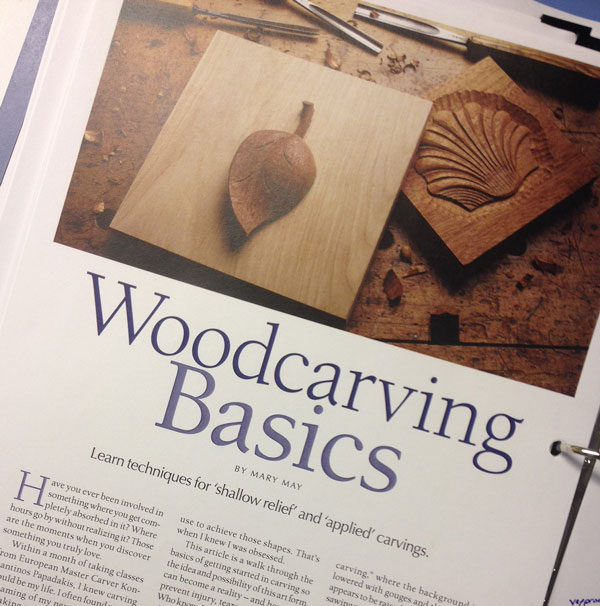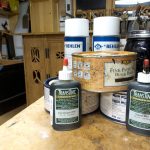We may receive a commission when you use our affiliate links. However, this does not impact our recommendations.
I just finished the binder read-through for the December 2014 issue, and in it, Mary May has an article titled “Woodcarving Basics.” Therein, she shares the tools and techniques you need for a successful start in carving, and one of her suggestions was so interesting that it caused me to pick up an iron for the first time in…I don’t know how long.
(We share office space with our parent company’s video/photography studios, and they film a lot of sewing and other fabric-related stuff here…don’t tell the Burda Style folks I used their nice iron on a piece of wood…)
p.s The December issue starts mailing about a week before Thanksgiving.
Here are some supplies and tools we find essential in our everyday work around the shop. We may receive a commission from sales referred by our links; however, we have carefully selected these products for their usefulness and quality.










If you really want to geek out on this method, go to the Yahoo group on home brew printed circuits
https://groups.yahoo.com/neo/groups/Homebrew_PCBs/info . People there have been using the toner transfer method for a long time and you will find discussion of which printers work better. I myself had real good results https://secure.flickr.com/photos/wb8nbs/6948931336/ . My laser printer is a Lexmark 4039 10plus. It has a menu setting for extra dark which deposits more toner. A big factor is the paper you use, need printer paper that is non porous so the toner doesn’t just soak into the paper when its melted. Paper with a high clay content so it’s extra white works better. Many people (me) have had good results using paper cut from one of those high grade slick magazines. Have not tried Popular Woodworking paper, but it’s a candidate.
I’ve done a similar thing to transfer onto metal for engraving, using acetone. Tape the pattern on one edge, rub an acetone soaked rag over the pattern, wait a few seconds, and lift to see if you have enough transfer. the taped edge lets you index it back down on the same spot if you didn’t get enough transfer. Too much acetone causes bleed. I don’t know how it’d work on wood, it might run too much. Taping one edge down does let you check the results though.
Amvolt’s reply is just what I was thinking; I’ve done this process on circuit boards plenty. There’s also some products ( Press and Peel Blue is what I’ve used) that basically always work for this method, at least on circuit boards. No idea if they work well on wood. I’ve also heard of folks doing this stuff with t-shirt transfers with success as well; readily available at craft stores.
The circuit board guys are going farther than we are here, things need to be perfect, because the ink needs to serve as a resist for the acid.
Two other tips- if you’re doing anything like text , remember to flip your image before printing! It flips in the transfer process, if you don’t compensate, you’ll get mirrored letters!
Also, if you don’t have a toner-based laser printer, most black and white photocopiers are. Bring your inkjet print down to the photocopier at the library and make a few copies!
I don’t believe you don’t iron, Megan. How else do you get your edge banding on plywood? 😉
You CAN transfer images from ink jet printers onto wood. See Steve Ramsey’s video on how. https://www.youtube.com/watch?v=Zq2O66QGCwg for how. The results are pretty stunning.
Hi Megan,
When you lifted the paper from the wood, it looked as though it was machine planed with a nicked set of blades. I could also see the rows of cuts. If you gave it a quick pass or two with a hand plane I believe you would get a better transfer – smoother surface.
I wonder if using the steam setting would help the transfer or just muck up the ink.
Another method that my wife tells me that works. Mind you, I haven’t tried it yet. Use freezer paper as your medium. Copy onto the shiny side of the freezer paper. It doesn’t matter if it’s cartidge or ink jet. Then iron as you mentioned in the video. The freezer paper doen’t hold the ink as well as copy paper does, due to the coating. My wife uses that method for transfering sewing patterns onto fabric all the time, so it should also work on wood.
People that do etching of printed circuit boards, patterns on copper and brass have been using this technique for a long time now. They call it “toner transfer.” You could look up some of those articles and blogs on the web. These people use desktop laser printers. Different manufacturer’s toner melts at different temperatures. HP seems to do well. Brothers melts at a higher temp.
I am so so tempted to make a really sexist remark…..but I won’t